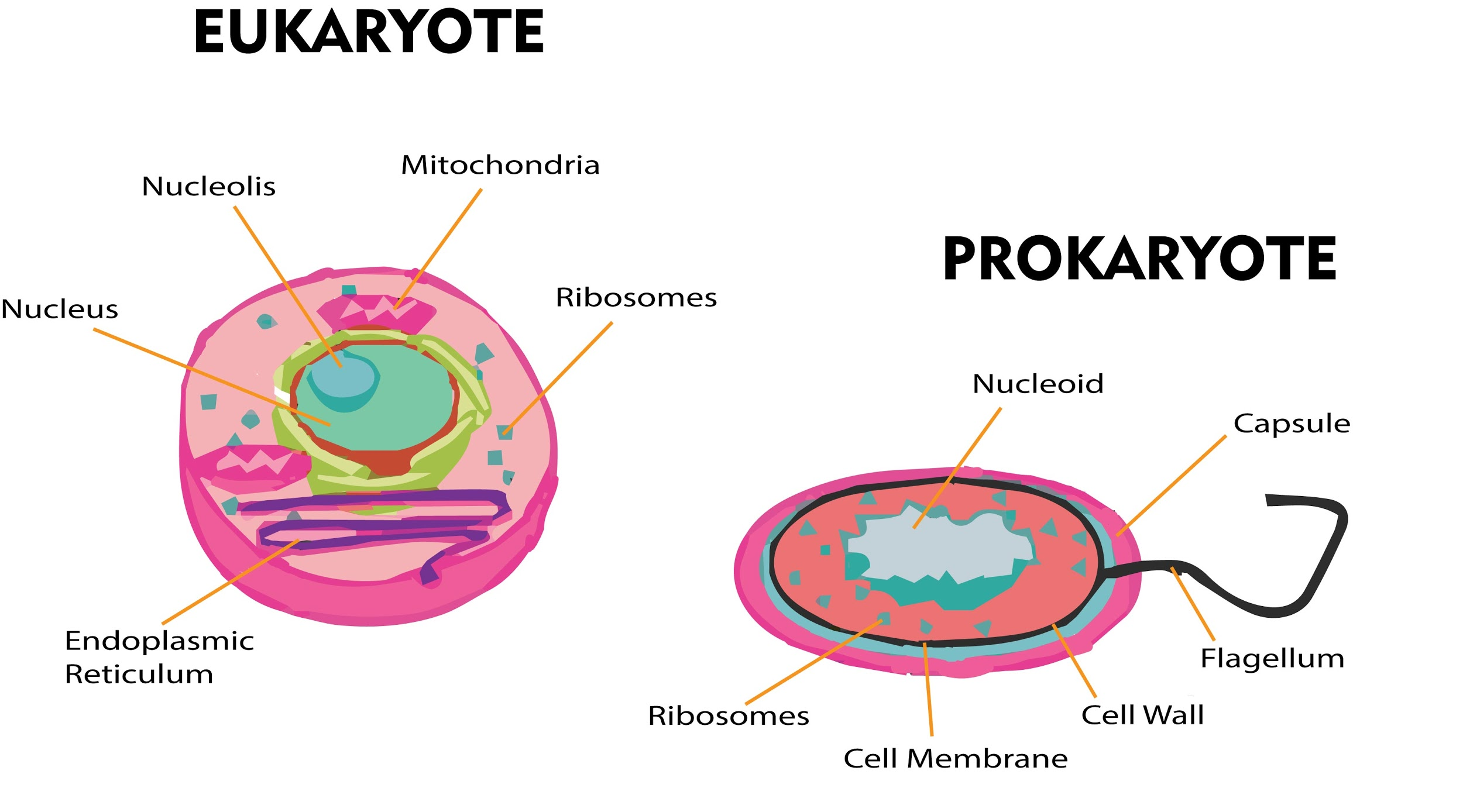
Prokaryotic cells are generally…………… and multiply ………….than the eukaryotic cells.
(a)Smaller, slower
(b)Larger, slower
(c)Smaller, faster
(d)Larger, faster
Answer
456.9k+ views
Hint Cells are the fundamental unit which is membrane-bound. Some cells acquire specialized functions as mature. The cells are much larger than the atoms but are still very small. Cells are made up of some major organic molecules such as proteins, carbohydrates, lipids, and nucleic acids.
Complete answer:
Prokaryotic cells are generally smaller and multiply faster than the eukaryotic cells. The cells which do not consist of an envelope enclosed nucleus are known as prokaryotic cells. They consist of flagellum which is a long protrusion that helps in aiding cellular locomotion that is used by gram-positive and gram-negative organisms. They are surrounded by the cell membrane cytoplasm which regulates the flow of substances inside and outside of the cell. The cell is protected by the bacterial cell by the cell wall which gives its shape. Organisms having nucleus enclosed in the nuclear envelope and known as eukaryotic organisms. These organisms constitute cell organelles which are membrane-bounded such as the Golgi apparatus, mitochondria, and chloroplast. They reproduce both asexually and sexually.
Additional information:
The transfer of DNA between the prokaryotic cells takes place in bacteria and archaea. The gene transfer takes place in three processes which include the bacterial virus-mediated transduction, plasmid-mediated conjugation, and the natural transformation. During the intracellular assembly of virus particles, the transduction of bacterial genes takes place by bacteriophages that reflect an occasional error. The transfer of host bacterial DNA appears to be an accidental process in the plasmid-mediated conjugation and natural bacterial transformation involves the transfer of DNA from one bacteria to the other with the intervening medium. The life cycle of eukaryotic organisms involves sexual reproduction which alternates between a haploid phase and a diploid phase with one copy of each chromosome present in each cell and two copies of each chromosome present in each cell respectively. Due to their smaller surface area, they have lower metabolic rates and longer generation times.

So, the correct answer is 'Smaller, faster'.
Note: It is discovered that our body contains around 75-100 trillion cells. Cell's nucleoid contains the cell’s DNA which is the source of genetic information. Cells can vary their size from 1-100 micrometers. Our body contains about 95% of bacterial cells among which the majority of them live on the skin. If a cell is infected or undergoes any damage it destroys itself and this process is known as apoptosis. If a cell is unable to undergo apoptosis it is the result of the development of cancer.
Complete answer:
Prokaryotic cells are generally smaller and multiply faster than the eukaryotic cells. The cells which do not consist of an envelope enclosed nucleus are known as prokaryotic cells. They consist of flagellum which is a long protrusion that helps in aiding cellular locomotion that is used by gram-positive and gram-negative organisms. They are surrounded by the cell membrane cytoplasm which regulates the flow of substances inside and outside of the cell. The cell is protected by the bacterial cell by the cell wall which gives its shape. Organisms having nucleus enclosed in the nuclear envelope and known as eukaryotic organisms. These organisms constitute cell organelles which are membrane-bounded such as the Golgi apparatus, mitochondria, and chloroplast. They reproduce both asexually and sexually.
Additional information:
The transfer of DNA between the prokaryotic cells takes place in bacteria and archaea. The gene transfer takes place in three processes which include the bacterial virus-mediated transduction, plasmid-mediated conjugation, and the natural transformation. During the intracellular assembly of virus particles, the transduction of bacterial genes takes place by bacteriophages that reflect an occasional error. The transfer of host bacterial DNA appears to be an accidental process in the plasmid-mediated conjugation and natural bacterial transformation involves the transfer of DNA from one bacteria to the other with the intervening medium. The life cycle of eukaryotic organisms involves sexual reproduction which alternates between a haploid phase and a diploid phase with one copy of each chromosome present in each cell and two copies of each chromosome present in each cell respectively. Due to their smaller surface area, they have lower metabolic rates and longer generation times.

So, the correct answer is 'Smaller, faster'.
Note: It is discovered that our body contains around 75-100 trillion cells. Cell's nucleoid contains the cell’s DNA which is the source of genetic information. Cells can vary their size from 1-100 micrometers. Our body contains about 95% of bacterial cells among which the majority of them live on the skin. If a cell is infected or undergoes any damage it destroys itself and this process is known as apoptosis. If a cell is unable to undergo apoptosis it is the result of the development of cancer.
Recently Updated Pages
Glucose when reduced with HI and red Phosphorus gives class 11 chemistry CBSE

The highest possible oxidation states of Uranium and class 11 chemistry CBSE

Find the value of x if the mode of the following data class 11 maths CBSE

Which of the following can be used in the Friedel Crafts class 11 chemistry CBSE

A sphere of mass 40 kg is attracted by a second sphere class 11 physics CBSE

Statement I Reactivity of aluminium decreases when class 11 chemistry CBSE

Trending doubts
10 examples of friction in our daily life

The correct order of melting point of 14th group elements class 11 chemistry CBSE

Difference Between Prokaryotic Cells and Eukaryotic Cells

One Metric ton is equal to kg A 10000 B 1000 C 100 class 11 physics CBSE

State and prove Bernoullis theorem class 11 physics CBSE

What organs are located on the left side of your body class 11 biology CBSE




